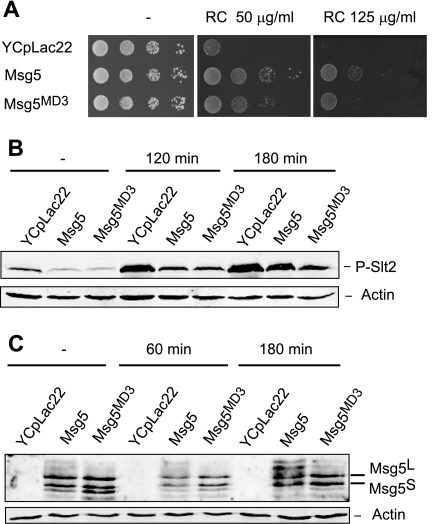FIGURE 9.
Effect of the lack of Msg5 MD3 motif on the CWI pathway. A, sensitivity to Congo red of msg5Δ (DD1-2D) cells transformed with the vector YCplac22m or plasmid YCplac22MSG5m (Msg5) or YCplac22MSG5MD3m (Msg5MD3). Cells were grown in liquid selective medium at 24 °C, and a 10-fold dilution series of this culture was spotted onto YPD agar medium in the absence (−) or presence of the indicated concentration of Congo red and incubated for 2 days at 24 °C. B, Western blotting analysis of the effect of the Msg5 MD3 mutation on Slt2 phosphorylation. The same transformants as in A were grown to mid-log phase in selective medium at 24 °C, and then aliquots were treated or not with Congo red (30 μg/ml) for 120 and 180 min. Protein extracts were prepared, and phospho-Slt2 and actin (as a loading control) were detected by immunoblot analysis with anti-phospho-p42/44 and anti-actin antibodies, respectively. C, Western blotting analysis of the effect of the Msg5 MD3 mutation on Msg5 phosphorylation. The same transformants as in A were grown to mid-log phase in selective medium at 24 °C, and then aliquots were either left untreated or exposed to Congo red (30 μg/ml) for 60 and 180 min. Proteins extracts were prepared, and Msg5–6Myc or Msg5MD3-6Myc and actin (as a loading control) were detected by immunoblotting analysis with anti-Myc and anti-actin antibodies, respectively. In all cases, reproducible results were obtained in different experiments, and selected images correspond to representative blots.

